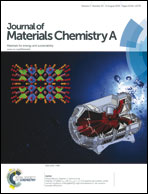Carbon nanofibers by pyrolysis of self-assembled perylene diimide derivative gels as supercapacitor electrode materials†
Abstract
Carbon nanofibers (CNFs) have a wide range of applications and are commonly prepared under harsh conditions with small quantities. A green method for the preparation of CNFs under mild conditions with the scalable potential is highly challenging. Here, we describe a facile water-based room-temperature approach to producing gel fibers from a perylene diimide derivative via self-assembly, gelation, freeze-drying, and then to generating CNFs by subsequent pyrolysis under Ar. The entangled CNFs, with relatively uniform diameters around 20–50 nm, can be prepared as thin films or monoliths. The CNFs doped with elements N and Sn can be readily produced. The CNFs are characterized by various techniques and particularly evaluated as electrode materials for supercapacitor by cyclic voltammetry and galvanostatic charge-discharge. A non-ionic surfactant (Pluronics F-127) can be easily incorporated into the self-assembly process, which produces the CNFs with a higher surface area 520 m2 g−1 and a specific capacitance of 346 F g−1 at the scan rate of 1 mV s−1 or 192 F g−1 at the current density of 1 A g−1. The CNF electrodes are highly stable. Quite surprisingly, the specific capacitance increases with repeated testing, achieving an impressive 226 F g−1 for 1000 charge/discharge cycles at 4 A g−1.


 Please wait while we load your content...
Please wait while we load your content...